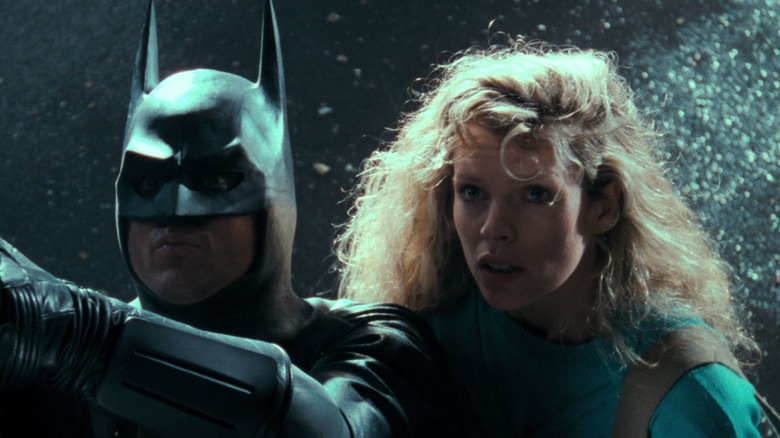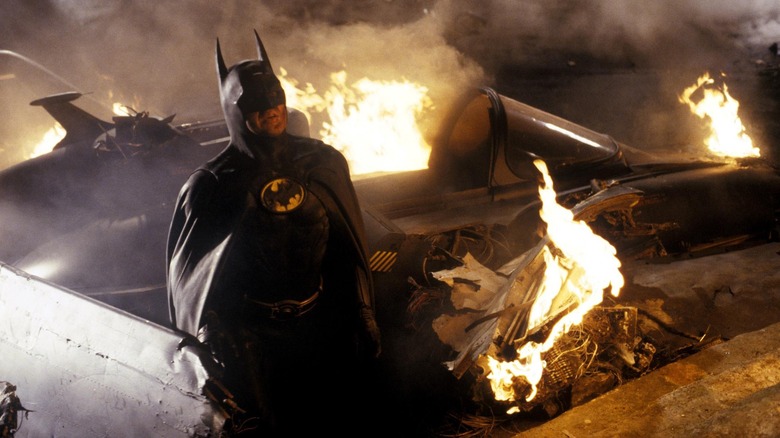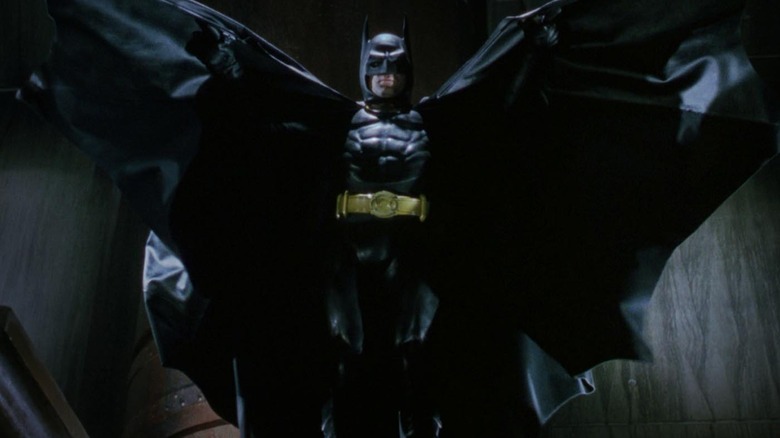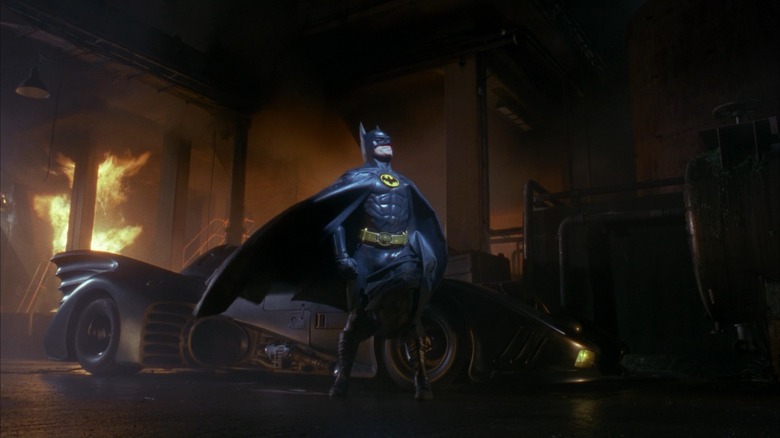Tim Burton's Batman Ending Explained: The Outsider Invited In
It cannot be overstated just what a massive hit Tim Burton's "Batman" was in 1989. It was an advertising bonanza the world hadn't ever seen before. In terms of cultural ubiquity, "Batman" handily outstripped "Star Wars," and nearly matched the franchise in its merchandising. In one of cinema history's sweetest plum deals, Jack Nicholson — who played the Joker — not only received top billing but cut his own salary to a mere $6 million in exchange for a percentage of the film's merch sales. He ultimately earned about $90 million. The film was made for a budget of $48 million. It earned about $411 million worldwide. That's nearly a billion dollars in 2022.
Given the tone and look of the movie, one might see the overwhelming success of "Batman" as a little odd. Designed after German expressionist films of the 1920s and 1930s, "Batman" was arch and artificial. It was shadowy and tragic. Unlike Richard Donner's "Superman" from 20 years previous, it wasn't an exhilarating, upbeat celebration of the character, but a dour, almost bleak film set in a world of poverty and darkness. In many ways, Burton's film was meant, at every step, to be an antidote to the hit 1966 "Batman" TV series, which had fallen out of favor in the '80s thanks to "darker" turns the character had taken in his comic book titles.
Hollywood responded to the success of "Batman" by producing a long string of movies based on Silver Age comics. Films like "Dick Tracy," "Darkman," "The Crow" and "The Rocketeer" followed. Curiously, few studios thought to make more films based on DC superhero comics.
Tim Burton's outsiders
Tim Burton has said in interviews that he is drawn to stories of outsiders. As a kooky Burbank local with strange interests, Burton himself always felt like an outsider, so it's no wonder that his movies tend to feature equally weird protagonists. Pee-wee Herman (Paul Reubens) from "Pee-wee's Big Adventure" is a grown child, obsessed with magic tricks and bicycles and living comfortably in his own world of contraptions and Mr. T Cereal. Most notably, Edward Scissorhands (Johnny Depp) is a black-clad, wild-haired machine-man with bladed fingers who cuts up anything he touches, despite his gentle demeanor and romantic heart. Edward spends the bulk of his film interacting with the callow demi-humans that exist in a pastel-colored post-World War II suburb. He does not belong in that world. His respite is a sensitive young woman (Winona Ryder) who can see past his strange exterior.
Burton himself, who shared equally wild hair, likely felt like Edward throughout his life. He was interested in spooky movies, death, and unusual media in a bright world of suburban uniformity. His characters also commonly appear to be torn. On the one hand, they have found a niche where they can live out their passions with ease and comfort. Lydia Deetz (Ryder) from "Beetlejuice" loathes her yuppie parents, but, in a stroke of luck, moves into a house with ghosts in it. Not only can she see the ghosts (others cannot), but she becomes their friend. The catharsis of being a Tim Burton character is that you have come to peace with your eerie interests and fashion style. It's worth noting that Tim Burton likely helped large portions of the Goth movement in the late 1980s.
Batman as outsider
One must pause to mention that there was some mild controversy in 1989 over the casting of Michael Keaton as Bruce Wayne. Many seemed to feel that Batman should be played by a more conventional "heroic" action star. Keaton was, at the time, better known for comedies like "Mr. Mom" and "Johnny Dangerously." Others objected to the design of the Batman suit, which featured some impressive fake musculature down its legs and abdomen. Burton has explained numerous times that his version of Bruce Wayne was a man who felt he lived in a fantasy. Wearing the Batman suit was a way to project a certain image to Gotham City's criminal underground, but was also a means for Bruce Wayne to look — and to feel — more powerful. This is not a Batman who is secretly asserting his power over others. He is not vengeance. He is a dark specter.
When photojournalist Vicki Vale (Kim Basinger) asks Bruce Wayne why he's Batman, he is already mature enough to answer curtly, saying that it's just something he has to do. This is a Batman who long ago stopped wrestling with his dual identity, and embraced it. It's telling that Burton only showed Batman's origin story — murdered parents in an alley — in flashback. Batman is a tortured outsider who has learned to live on the outside. His wealth is a buffer keeping him out. In a symbolic scene, Bruce and Vicki dine at a fancy dining table that is so long, they can barely see one another. Bruce has to joke about his wealth — "I don't think I've ever been in this room before!" — to retain his humanity.
Finally welcomed in
The end of "Batman" is not terribly difficult to understand from a plot perspective. The Joker lures the impoverished citizens of Gotham City to a public parade, promising to dump cash on the crowd. The Joker does indeed give away cash ... and clouds of poison gas. Using his personalized airplane, Batman disposes of the balloons, crashes it, and chases the Joker into a tall Gothic church where the two duke it out. The Joker falls to his death after Batman tethers a gargoyle statue to his foot. The Dark Knight triumphant.
It's the epilogue that is important. After proving himself a positive force in Gotham City, Batman offers up his Batsignal to the police department. Whenever he is needed, the cops can call on him, and Batman can charge into action. Previously an outsider, Batman has proven himself beloved, and wanted. An outsider is being welcomed into the mainstream.
This is very clearly a parallel to Tim Burton himself. A kooky outsider, previously shy and awkward, has now been allowed into the Hollywood firmament. He, like Batman, proved himself beloved and wanted by making one of the most financially successful films of all time. An outsider is being welcomed into the mainstream. Burton's aesthetic dictated a lot of Batman media that followed (notably "Batman: The Animated Series"), and he went on to make further strange, exciting blockbusters — usually about outsiders — for major studios. Batman had a Batsignal. Burton had contracts. In both cases, an unlikely figure in a strange city became its offbeat savior.



